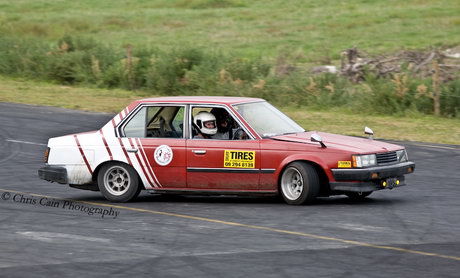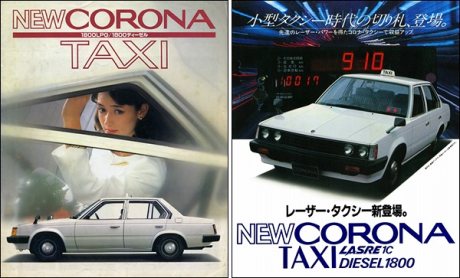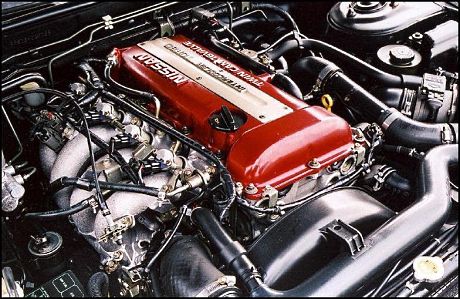Best viewed postings of 2009!
Time to do a most popular list for us as well!
The top 3 most popular postings this year were:
3:
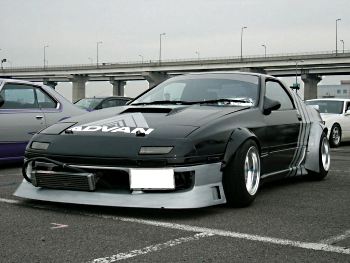
Rare Bosozoku cars: Mazda RX7 FC
2:
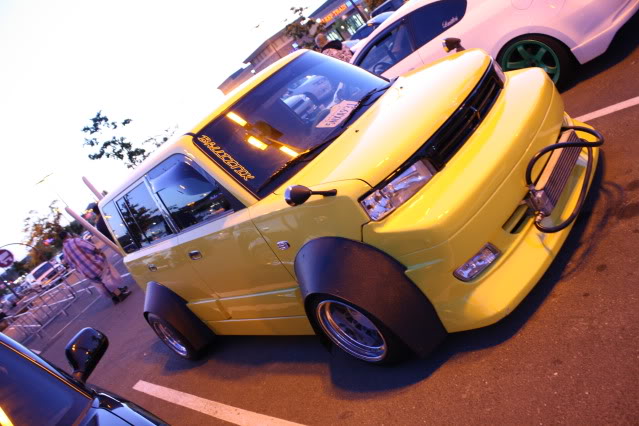
Bosozoku car feature: James’ Scion xB
1:
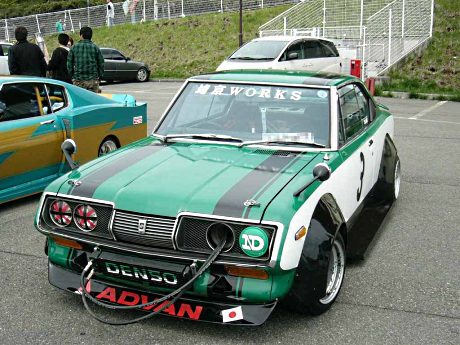
Rare Bosozoku cars: Toyota Corona Mark II T60/T70
Thank you all for visiting and supporting us during the past year! 🙂
by banpei with 1 commentRare Bosozoku cars: Toyota Corona Mark II T60/T70
This week we feature the first of the popular Mark II series: the Corona Mark II T60/T70 series. This Corona Mark II coupe may not be a GSS coupe but it surely does look well under that bosozoku skin:

Bosozoku style Toyota Corona Mark II coupe RT70
Eventhough the later Mark II models are immensively popular as zokusha the first Corona Mark II series is not popular at all! So far this is one out of two Corona Mark IIs we ever encountered.
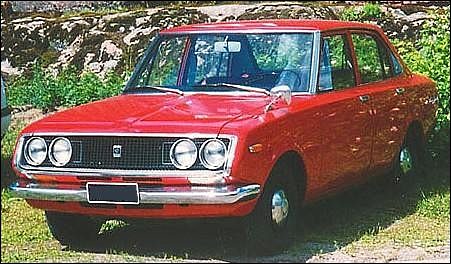
Factory stock zenki Corona Mark II RT60
The Corona Mark II was basically a model designed to fit between the middle class Corona and the upper class Crown. It was only slightly larger than the Corona but it did have a lot of luxuries only to be found in the Crown, like better seats and larger engines. The car was produced as sedan, wagon, coupe and hardtop coupe. The sedan and wagon look very much alike the Corona T40/T50 (a bit dull) while the coupes are sleekly styled after late 60s American cars.
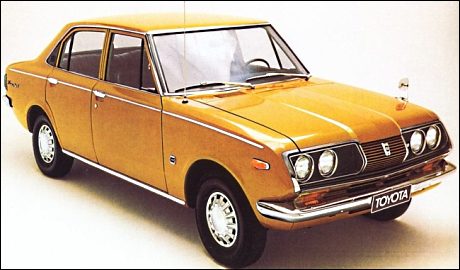
Factory stock kouki Corona Mark II RT62
The Corona Mark II engine range started with the 1.5 liter 2R and ended with the 2 liter 18R. Eventhough normally bigger is better this did not apply to the Corona Mark II: it featured the 10R engine which got later renamed to the 8R-G. If you are a Toyotaku the G typing should already ring a bell: it means twincam (DOHC) with sidedraft carburetors!
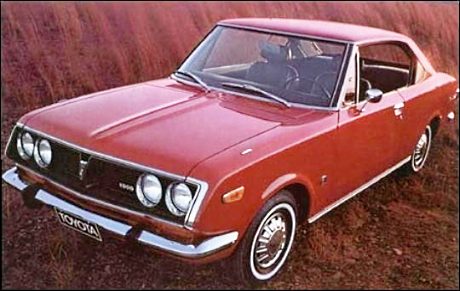
Factory stock Corona Mark II Coupe RT72
The 10R/8R-G was a 1.9 liter engine and was capable of producing 140HP and was placed in the top of the range Corona Mark II: the RT75 GSS hardtop coupe, which after the facelift and 8R-G renaming got the RT72 designation. The GSS was mated with a 5 speed gearbox and weighted only 1050 kg so it had an amazing power to weight ratio for its era: 7.5 kg/hp (16.5 lbs/hp), that is more than the 1969 MGB was capable of! Well the 3 liter MGC came near these figures but it had 1.5 times as big displacement as the Corona Mark II! The Corona Mark II GSS was capable of reaching 200 km/h and doing the quarter mile in 16.60 seconds! Amazing performance for a factory stock car in the late 60s!
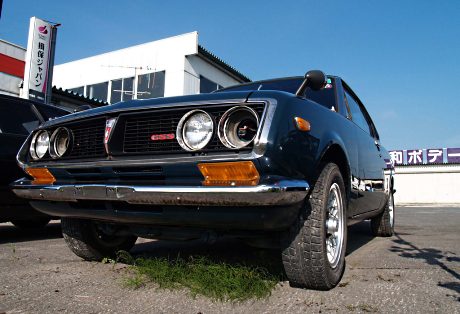
Corona Mark II GSS Hartop Coupe RT75
Even though examples of bosozoku styled Corona Mark IIs are really hard to find it don’t think it was an impopular zokusha during the early 80s. The reason it is a rare find nowadays is mainly because most of them are too far gone!
Rare bosozoku cars: Toyota Corona T14
I have a weak spot for the Toyota Corona T14 series: they are closely related to the Toyota Carina and Celica.
I found this great bosozoku styled Corona some time ago on multiple meetings and picture galleries:
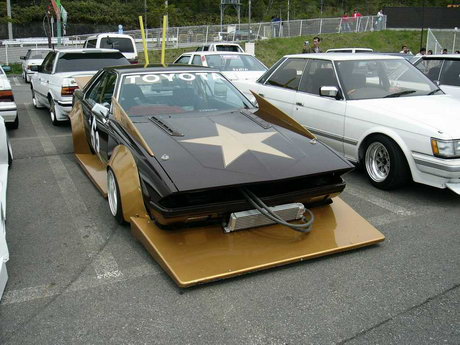
Bosozoku style Toyota Corona T14
It has been modified seriously with a sharknose, fins, big lip, oil cooler, deep dish wheels, tsurikawa and a big V-shaped exhaust! Unfortunately I could not find a picture rear of the car including the V-shaped exhaust:
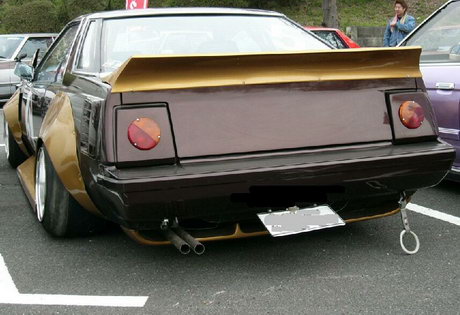
Bosozoku style Toyota Corona T14
Unfortunately this is the only Corona T14 I could find grachan/bosozoku styled pictures of… On the other hand I could find shakotan styled Coronas in large amounts:
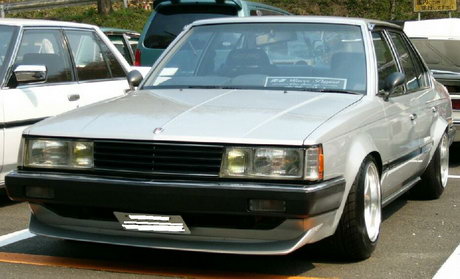
Shakotan styled Toyota Corona T14
That is very understandable: this last RWD Corona and they are mainly used for drifting nowadays. This series offered a cheap, relatively lightweight car and featured some new generation engines with great potential, it is probably one of the best cheap cars for students nowadays. Where did we hear that before?
During the 70s Toyota created a great diversity in platforms: they had the Publica (P), Corolla/Sprinter (E), Celica/Camry/Carina (A), Corona (T), Mark II (X) and Crown (S) and a few other platforms on which they built their cars. Toyota decided to merge the Corona and Celica platforms to cut costs and did this starting with the Corona T14 and Celica/Camry A5 generations. The Celica/Camry/Carina wheelbase remained the same, but the Corona wheelbase shrunk by 25 mm.
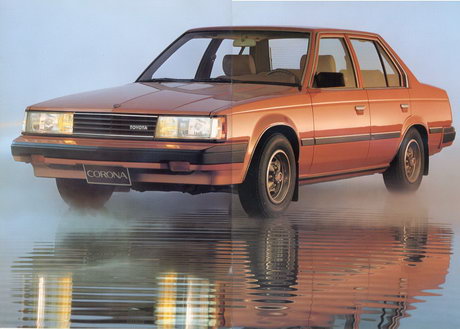
Factory stock Corona TT140 sedan
The Corona was positioned above the Carina and offered, just like the Carina and Celica, independent rear suspension on all luxurious and sports models. The wagons were based on the same platform as the Carina so Toyota only changed the front section to match the Corona look. The rear section of the wagon is entirely the same as the Carina, including the live axle.
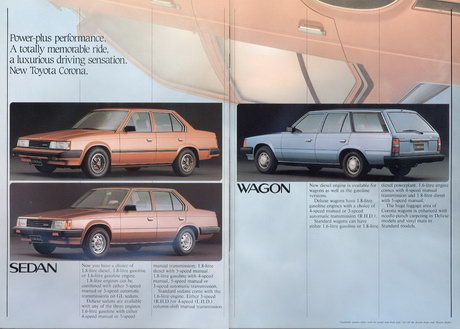
Factory stock Corona sedan and wagon
Later on Toyota also offered the Corona as a taxi with a LPG engine. This Corona was basically a mix and match of the Corona and Carina: front looked like the Carina while the mid and rear section were Corona. Later taxi models featured the Carina taillights.
The Corona hardtop Coupe was targeted as the grand tourer edition of the Celica and positioned between the Celica and the Soarer. It offered great luxury above the spartan Celica and Celica XX models while it had less luxurious options as the new Soarer.
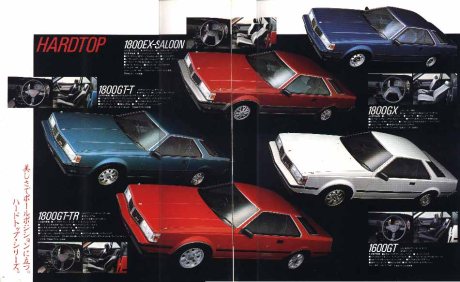
All varieties of the Toyota Corona hardtop coupe
Toyota had borrowed some styling cues for the Corona T14 from BMW: the nose had a slight wedge in it, its rear section featured a BMW style rear door and its boot and taillights were slightly borrowed from the BMW 7 series of that era:
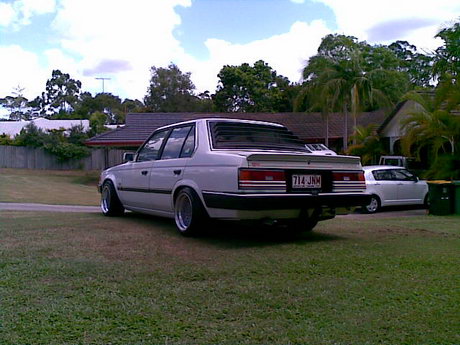
This Corona sedan shows its BMW lines
The Corona offered, like the Carina, a great variety of engines: from the 1.5 liter 3A-U till the 2.4 liter 22R. Of course it featured the sporty 135hp 18R-GEU and 130hp 4A-GE in the GT and the performance 160hp 3T-GTE engine in the GT-T.
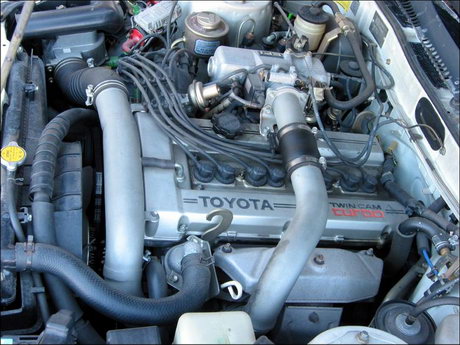
The mighty 3T-GTE twin cam 16 turbo engine
After this series the Corona and Carina models merged, the platform changed to FWD and started to feature a bit more dull styling. The Corona T14 series is the last great Corona.
by banpei with no comments yetRare Bosozoku cars: Unknown car
People who read my personal blog already knew it, but I got married yesterday. I was hoping I would have a few minutes to post something for the rare bosozoku cars regular, but as it turned out to be I didn’t… So you have to be satisfied with some vip/bosozoku styled car which we could not identify…
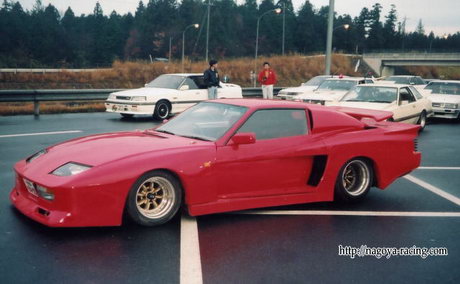
Unknown bosozoku styled car. Looks like a 80s Koenig Testarossa
It looks like it should resemble a Koenig Testarossa.
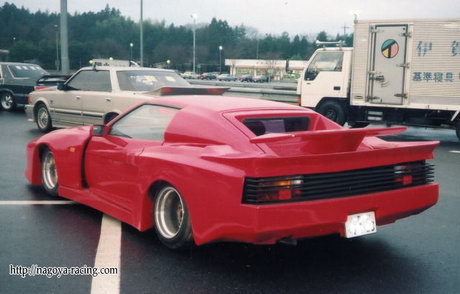
Unknown bosozoku styled car. Looks like a 80s Koenig Testarossa
Back in the late 80s and early 90s Koenig was one of the most immitated tuners in the bosozoku styling. Their wild widened bodies with extravaganza spoilers was exactly what the bosozoku car should look like!
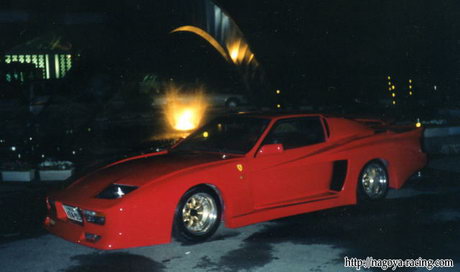
Unknown bosozoku styled car. Looks like a 80s Koenig Testarossa
What also helped was that gang bosses drove around in VIP cars (Mercedes, BMW, etc) which had been modified by tuners, like Koenig.
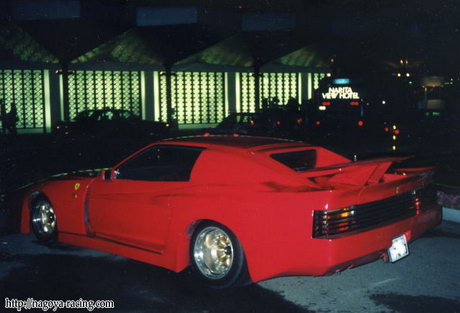
Unknown bosozoku styled car. Looks like a 80s Koenig Testarossa
The pictures were taken by Nagoya Racing and they look like they were taken during the early 90s…
Anyway, we were not able to identify the source for this car. Maybe you can help out?
by banpei with 2 commentsRare Bosozoku cars: Nissan S13 180SX
Last weekend we featured a very nicely exhaust of the week: a bosozoku styled Nissan 180SX!
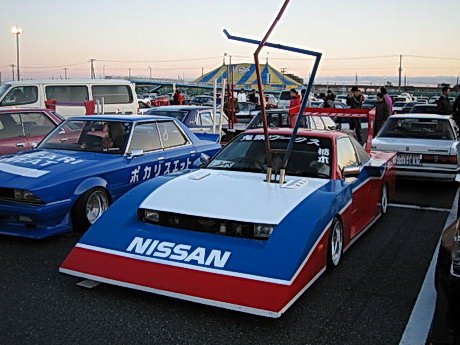
Exhausts look like a sculpture on this RPS13 180SX
The 180SX is a rare sight on the bosozoku meetings! We only found two examples of a 180SX and we even suspect that it is actually the same car!
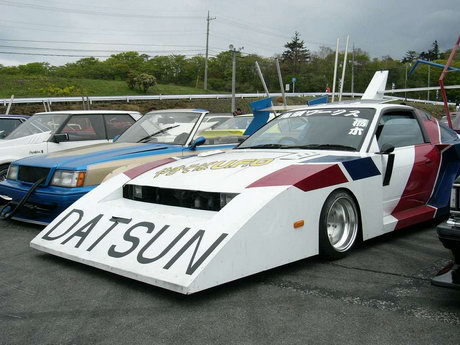
Bosozoku styled Nissan 180SX S13
Great mystery is why it is badged Datsun and not Nissan: the 180SX is too new to be badged Datsun abroad and in Japan Nissan never marketed as Datsun!
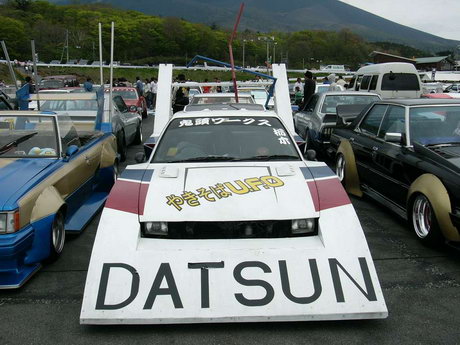
Bosozoku styled Nissan 180SX S13
The styling of this 180SX is a grancha version of the 180SX: you can’t even recognize it except by its roofline. It looks a bit more like a successor of the super silhouette formula Nissan Silvia Turbo S12!
When the Nissan S platform got into its fourth generation in March 1989 it created the Nissan 180SX (aka 200SX and 240SX abroad). The Nissan 180SX S13 was basically the successor in looks of the Nissan Silvia S12. The Nissan Silvia 180SX was a trim level of the Silvia S110 and the Silvia S12 was already well known in the US as the 200SX (without Silvia badging). It was quite naturally for Nissan to name the car with the SX badge when they decided to split up the Nissan S platform into two seperate models. This created the Nissan Silvia S13 and the Nissan 180SX S13.
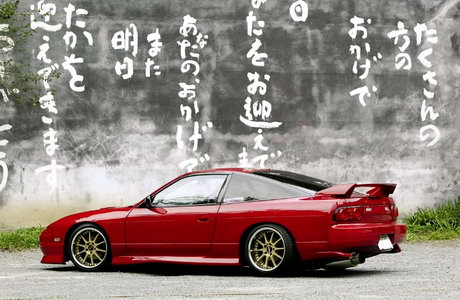
Factory stock kouki Nissan 180SX S13 Type X
In Japan the Silvia got a coupe bodytype with fixed headlights while the 180SX got a fastback (aka hatchback) bodytype with popup lights. It didn’t take long before the first combinations of those two started to appear in the streets: street racers who wrecked their 180SX frontends mated that with the lighter and cheaper Silvia frontend and created the Sileighty (aka Sil80) this way. The other way around wasn’t popular since it was heavier and required changes in the wiring. When Nissan spotted these conversions they decided to have an “official” Sileigthy as well. They had them produced by Kids Heart and sold some of those cars through the official Nissan dealer network. Also different combinations exist: S13.4 (S13 mated with Silvia S14 frontend) and S13.5 (S13 mated with Silvia S15 frontend, aka strawberry face) since the S platform remained the same.
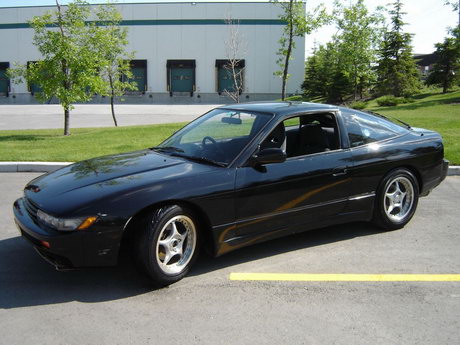
Nissan Silvia S13 and 180SX crossover: Sileighty
The 180SX initially got a 1.8 liter CA18DET, hence the 180SX designation, but in 1991 it got upgraded with the SR20DET engine and later on in 1996 with the SR20DE engine. It remained badged as the 180SX and not as the 200SX. Funny enough the 180SX was badged as the 200SX in Europe with the CA18DET engine and never got the SR20DET engine. In the US it was badged as the 240SX since it was powered by the KA24E and KA24DE engine: Nissan thought the US needed displacement instead of smaller turbo engines.
At first the 180SX was available as two versions: the Type I and Type II. The Type I was targeted for performance while the Type II was targeted for luxury. After the first facelift in 1991 the 180SX Type I got the SR20DET engine and got bigger brakes and a limited slip differential factory installed to handle the car better after this power increase. The Type II got the four wheel steering system HICAS II which got improved after the first facelift with the Super HICAS. After the second facelift in 1992 the Type III became available which was even more luxurious than the Type II: it got climate control and a cd player factory installed. After the third facelift in 1994 the Type I and Type II trim levels were renamed to Type R and Type X and the fourth facelift in 1995 only added a driverside airbag. The final facelift in 1996 had a lot of visual changes and added the cheaper Type S trim which offered the non turbocharged SR20DE and lacked the four wheel steering system. Production of the 180SX finally ceased in December 1998.
A great video of Ken Nomura (Nomuken) visiting the 180SX Type X assembly line in the Nissan factory somewhere late 90s:
The 180SX still remains very popular nowadays: it is a cheap mass produced rear wheel drive sportscar. Both its engine types have big potentials: both CA18DET and SR20DET can easily be tuned over 300HP and figures end somewhere between 500 and 700HP! Since the platform itself remained roughly the same almost all suspension upgrades for the newer S15 can be used on the S13 as well. Most people use the 180SX for drifting nowadays and it is often seen at MSC drift events!
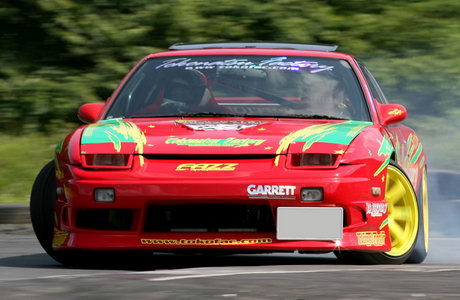
A Nissan 180SX driver participating in the MSC drift championship
In case you are wondering about the S13 designations you see at your average drift coverage: R stands for fastback/hatchback, P stands for SR20DE(T) and K for HICAS II/Super HICAS. That last designation will most probably be disabled on that car I guess… But of the time you will see either RPS13 (180SX with SR20), or RS13 (180SX with CA18), PS13 (Silvia with SR20) or plain S13 (Silvia).
I can imagine why the 180SX never got to be a popular bosozoku style car: it is too new to be popular in the 90s, it is too flashy and it is too modern styled. The examples above don’t leave much detail of the 180SX to be seen, so can we actually account them for a bosozoku styled 180SX?
by banpei with 1 comment